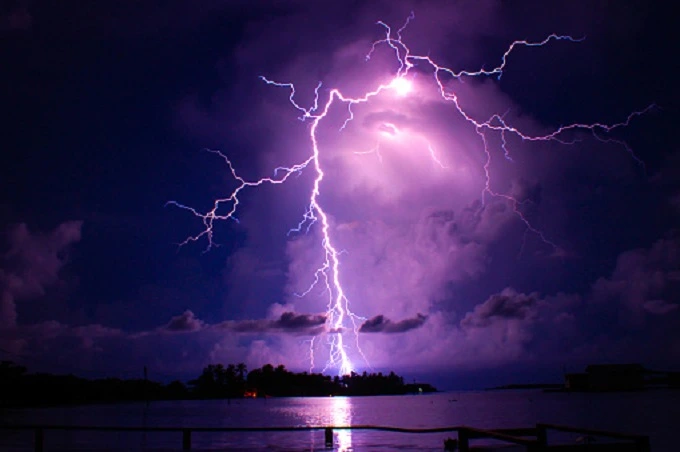The riddle of beacon of Maracaibo

The wetlands in Venezuela’s southern half of Lake Maracaibo are home to an extraordinary sight: a tremendous and practically continuous thunderstorm with up to 20 000 lightning flashes every night over the lake’s southwestern part. This is the world-famous beacon of Maracaibo or Catatumbo lightning, which is the longest continuous thunderstorm ever recorded in the world. Although it is not known when this occurrence first began, it has undoubtedly made its way into the history of indigenous peoples throughout the world.
Beacon of Maracaibo or Catatumbo lightning was well described by the famous naturalists Alexander von Humboldt and Agustin Codazzi. They described it as a continuous flash emanating from the vicinity of the Zulia River.
Other scientists conducted research on the mechanism of Catatumbo lightning throughout the 19th century and early 20th centuries. Catatumbo lightning, according to Melchor Bravo Centeno in 1911, arises as a result of the unique wind regime that exists in the area and the geographical characteristics.
Andrey Zavrotsky, a Venezuelan scientist of Russian origin who organized three expeditions in 1966-1970, discovered three epicenters of Catatumbo lightning: in the swamp of the Juan Manuel de Aguas National Park, Claras Aguas Negras, and west Lake Maracaibo., all of which were located in the same general area. Many people at the time thought that the evaporation of oil created lightning. Still, Zavrotsky refuted this theory by demonstrating that there was no oil in two of the three locations he identified as epicentres of lightning.
Nelson Falcon’s expeditions and the work of other scientists led to the discovery of a new hypothesis: the pyroelectric mechanism. He hypothesizes that the winds that blow across the plains of Maracaibo accumulate methane, which is then used to fuel lightning charges. Although there are numerous locations around the globe where the quantity of methane in the air is much greater, such a phenomenon has not been recorded in any of these areas.
On September 27, 2005, Catatumbo Lightning was declared a natural heritage site of the State of Zulia. They were also included in the preliminary list of UNESCO World Heritage Sites.
In January 2010, an extraordinary incident occurred: the Catatumbo lightning vanished without a trace. The lake of Maracaibo was shrouded in darkness. However, comprehensive investigations have shown that the discharge process proceeded even though the lightning was not visible to the human eye. The most probable explanation for the stoppage was Venezuela’s very dry weather conditions.
After a three-month break, the Catatumbo lightning returned in April of the following year. Before then, this occurred just once, in 1906, and for a total of three weeks in that year. This occurred as a result of a tsunami triggered by a cataclysmic earthquake of a magnitude of 8.8 that struck Japan.
Lightning has been spotted in the state of Zulia in the region between 8°30′ and 09°45′ southwest and 71°-73° south-east (Venezuela). Catatumbo lightning, in c ontrast to typical thunderstorms, constantly happens in the same location and may be viewed for 10 hours on 140-160 nights every year, on average.
The storm begins around an hour after sunset and lasts for many hours. Even though it is incredibly powerful (up to 20 000 flashes each night), the charges have a combined power of more than 400 thousand amperes.
Thunderstorms rage on the foothills of the mountain, accompanied by massive thunderclouds. During the night, the plain of Maracaibo is often free of clouds. Boats make their way out into the lake, where passengers may take in the breathtaking natural spectacles that surround them.
Thanks to the clear sky, lightning is visible from afar, even in the Caribbean Sea — even from a distance of 500 km. This is how the second name of this phenomenon arose — the Maracaibo Lighthouse. It is unlikely that a person will be able to build a lighthouse brighter than this.
Furthermore, these lightning bolts are often orange and red in colour. Some academics, as well as journalists and tour operators, think that the peculiar chemistry of the Catatumbo region is responsible for these characteristics. It is really simply regular lightning; the bright sky above Lake Maracaibo enables you to view a long distance since a thunderstorm occurs 50-100 kilometres away from the lake.
Thunder is only occasionally and faintly heard at this distance. The roar of thunder does not go this far, becoming disoriented halfway through. The peculiar colour of the atmospheric phenomena is responsible for the stated distance and the particles of dust and vapours in the air.
Because only electrical discharges between different parts of the thundercloud can be seen at such a considerable distance, there has been a widespread misconception that Catatumbo lightning, unlike conventional lighting, does not hit the earth. This, of course, does not relate to the facts of the situation.
Even now, scientific investigation of Catatumbo lightning continues, with new explanations being discovered. However, it is most probable that everything was clarified in 1911. The unique local topography, wind, and heat interaction is most likely the key to solving the mystery.
High mountains surround the plain of Maracaibo on two sides, creating a natural barrier. A specific wind (low air currents) flows from the northeast, which happens to be the only direction that is not blocked by the mountain range. Over the course of the day, the intense tropical sun warms the lake and wetlands, producing hot vapours that saturate the surrounding air.
The wind meets the high mountains at the southwest corner of the plain. Electrically charged volumes of moist and hot air are compelled to rise in this area. Thunderclouds are formed due to the condensing of vapour, and an electric discharge occurs.
According to scientific estimations, lightning in Maracaibo contributes to around 10% of the total tropospheric ozone in the world’s atmosphere.
The absence of the Catatumbo lightning in 2010 sparked concern, with some speculating that the climate on the earth is changing rapidly. According to environmentalists, human activity in the area, including deforestation and agricultural growth, is believed to be the root source of this danger signal.




